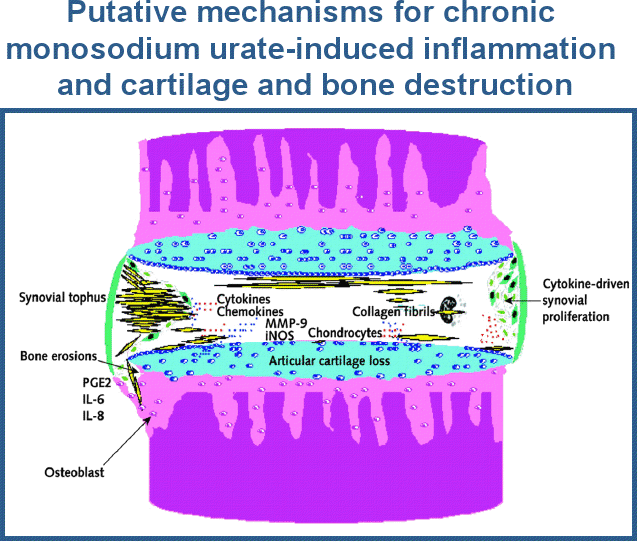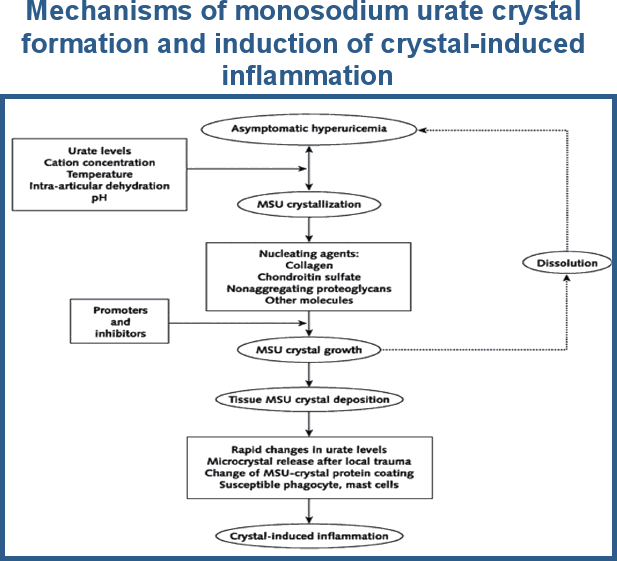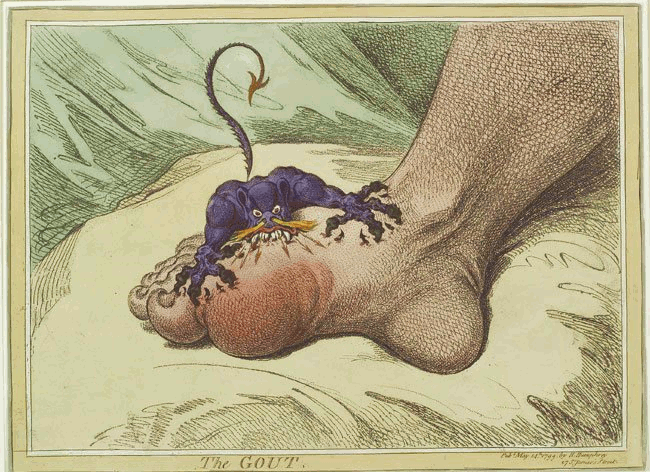Keith’s GoutPal Story 2020 › Forums › Please Help My Gout! › Uric Acid › Does Gout Hurt?
- This topic has 6 replies, 4 voices, and was last updated 10 years, 7 months ago by
Keith Taylor (GoutPal Admin).
-
AuthorPosts
-
April 8, 2011 at 4:17 am #3536
KeithTaylor
ParticipantFrom GOUT, GOUT, GOUT—-its everywhere!:
1) Why Does Gout Hurt?

?
2) Why Gout Does Not Always Hurt

Lots of factors affecting a) Why crystals form, and b) Why they cause inflammation.
?
They say a picture is worth a thousand words. How much are pictures worth when they contain words you don't understand?
 April 8, 2011 at 4:36 am #11351
April 8, 2011 at 4:36 am #11351Keith Taylor (GoutPal Admin)
ParticipantI've just found the explanations that should accompany those images.
For the first image of a damaged joint:
Low-level inflammation persists during the remissions of acute flares. Cytokines, chemokines, proteases, and oxidants involved in acute inflammation contribute to chronic inflammation leading to chronic synovitis, cartilage loss, and bone erosion. Monosodium urate (MSU) crystals are able to activate chondrocytes to release interleukin-1, inducible nitric oxide synthetase, and matrix metalloproteinases, leading to cartilage destruction. Similarly, MSU crystal activation of osteoblasts, release of cytokines by activated osteoblast, and decreased anabolic function contribute to the juxta-articular bone damage seen in chronic MSU inflammation. IL interleukin; iNOs inducible nitrous oxide synthase; MMP-9 matrix metalloproteinase-9; PGE2 prostaglandin E2.
For the second image of factors affecting the solubility of uric acid in the joint:
Urate crystallizes as a monosodium salt in oversaturated tissue fluids. Its crystallization depends on the concentrations of both urate and cation levels. Several other factors contribute to the decreased solubility of sodium urate and crystallization. Alteration in the extracellular matrix leading to an increase in nonaggregated proteoglycans, chondroitin sulfate, insoluble collagen fibrils, and other molecules in the affected joint may serve as nucleating agents. Furthermore, monosodium urate (MSU) crystals can undergo spontaneous dissolution depending on their physiochemical environments. Chronic cumulative urate crystal formation in tissue fluids leads to MSU crystal deposition (tophus) in the synovium and cell surface layer of cartilage. Synovial tophi are usually walled off, but changes in the size and packing of the crystal from microtrauma or from changes in uric acid levels may loosen them from the organic matrix. This activity leads to ?crystal shedding? and facilitates crystal interaction with synovial cell lining and residential inflammatory cells, leading to an acute gouty flare.
At last, all becomes clear


 April 8, 2011 at 7:09 am #11353
April 8, 2011 at 7:09 am #11353zip2play
ParticipantI'll stick with that picture of a devil chewing on the screaming guy's foot.
 April 9, 2011 at 2:10 am #11359
April 9, 2011 at 2:10 am #11359Keith Taylor (GoutPal Admin)
ParticipantAh, yes – good old Gillray. Interestingly, it's a foot only picture, but you just know the guy is screaming.
 April 20, 2011 at 7:29 pm #11455
April 20, 2011 at 7:29 pm #11455azasadny
ParticipantKeith (Gout Admin) said:
Ah, yes – good old Gillray. Interestingly, it's a foot only picture, but you just know the guy is screaming.

I love this picture because it explains what gout pain feels like better than I ever could…
April 21, 2011 at 12:23 pm #11463zip2play
ParticipantThe only problem I have with the image is that for me the devil seemed like he was chewing his way OUT. There is the AWFUL feeling with gout that the pain is deep within.
It's uniquely horrible. Hard to believe that a pain in one's foot can almost make one gag.
April 22, 2011 at 3:10 am #11470Keith Taylor (GoutPal Admin)
ParticipantNote to those who suspect gout, but dismiss it because they do not have symptoms so severe.
?
What makes gout so “uniquely horrible” is the role of uric acid. Harking back to the second image I posted, we can see that there are many factors that can influence the amount of uric acid crystals that form in the body. Each crystal attracts the attention of your immune system. Once detected by white blood cells, each crystal is attacked. Two things happen here:
1 – the white blood cell undergoes changes that allow it to engulf the crystal, which is the prime cause of inflammation.
2 – the cell signals for reinforcements, which magnifies the effects, and at least one of the signalling mechanisms is enhanced by uric acid.
Thus you have a rapidly expanding inflammation area that creates a vicious cycle of pain encouraging more pain, until all crystals are surrounded by white blood cells.
?
This happens frequently in the big toe because uric acid solubility is affected by temperature, but if your lifestyle gives you warm toes, with another joint at lower temperatures (in my case, my ankle, probably due to long distance driving), then that joint may well be affected first. In many cases, the number of uric acid crystals is not high enough to create the vicious cycle, but may result in much lower levels of inflammation, often barely noticeable. So you might still have gout without an episode of excruciating pain, but if you wait long enough, without treating the high uric acid levels, your turn will come.
-
AuthorPosts
- You must be logged in to reply to this topic.